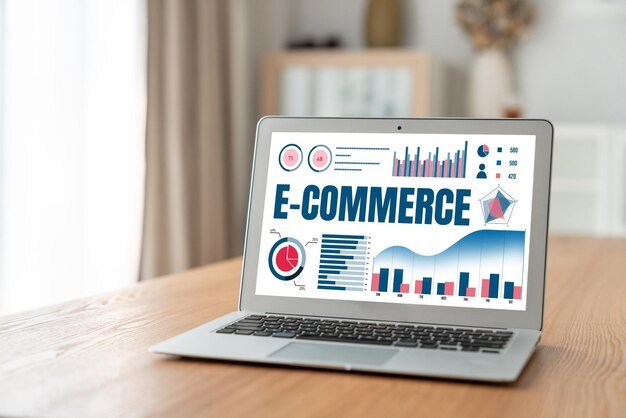When you shop online, the website you visit has a big impact on your experience. Whether you’re buying a new outfit, a gadget, or something for the home, the design of an e-commerce site can make or break a sale. Your site’s layout, ease of navigation, and overall look all play a role in making customers feel comfortable and ready to buy. So, how does the design of your website affect both user experience (UX) and sales? Let’s dive in and see why the design of your e-commerce site is crucial for success.
The First Impression Matters: Why Website Design is Crucial for First-Time Visitors
Imagine walking into a store and seeing a messy, cluttered space. You’d probably turn around and leave, right? The same thing happens when a potential customer lands on your website. The first thing they’ll notice is how your site looks. A clean, well-organized design immediately tells visitors that you’re professional, trustworthy, and serious about your business.
On the flip side, if your site looks outdated or confusing, visitors will start questioning your credibility. They’ll likely move on to a competitor without thinking twice. A solid website design makes a good first impression. It helps users understand who you are, what you offer, and how they can shop with you—all in a matter of seconds.
Simplified Navigation: Helping Customers Find What They Want Faster
Let’s be honest; no one likes spending ages searching for something. If your website’s navigation is confusing, it will frustrate visitors. If they can’t find what they need in just a few clicks, they’re gone. A clear and easy-to-use navigation menu is one of the most important aspects of good website design. You want to make it simple for customers to find the products they’re looking for.
Good navigation helps visitors move through your site effortlessly. Organize your products into logical categories. Offer a search bar to allow customers to find specific items quickly. Include filters like size, color, or price range to help users narrow down their options. A simple, effective navigation system will help customers feel comfortable and confident as they browse. The easier you make it for them, the more likely they are to make a purchase.

Mobile-First Design: Catering to the Growing Mobile Shopper Base
We all love shopping on our phones, don’t we? More than half of all web traffic now comes from mobile devices. That’s why it’s essential to ensure your ecommerce website is mobile-friendly. If your site doesn’t look good on a phone, you could be losing out on a lot of sales.
Mobile-first design is not just a nice-to-have feature; it’s a must in today’s digital world. People expect to browse and shop on their phones just like they would on a computer. Make sure buttons are easy to tap, forms are simple to fill out, and your pages load quickly. A responsive design adjusts automatically to fit different screen sizes, making it easier for mobile users to navigate.
A mobile-friendly website provides a better user experience and encourages more sales. If your site isn’t optimized for mobile, now is the time to fix that.
Clear Product Presentation: Using Images and Descriptions Effectively
When shopping online, we can’t touch or try on products. All we have are the pictures and descriptions. That’s why clear, high-quality images are so important. If your product images are blurry or not well-lit, customers may feel unsure about what they’re actually buying. On the other hand, good images give potential buyers the confidence they need to complete their purchase.
Provide multiple angles of each product so customers can see it from every side. Allow them to zoom in and take a closer look. Along with quality photos, make sure your product descriptions are thorough but easy to understand. List important details like size, color, material, and features. The more information you can give, the more confident your customers will feel about buying from you.
With well-presented products, customers are more likely to buy because they know exactly what they’re getting.
Speed and Performance: Why a Fast Website is Essential for Retention
How do you feel when a website takes forever to load? Frustrated, right? It’s the same for your customers. A slow website can cost you sales. Studies show that even a one-second delay in loading time can cause a 7% drop in conversions. In other words, if your site takes too long to load, you’re losing money.
Website speed affects more than just user experience. It also impacts your SEO. Google rewards fast websites with better search rankings. So, if your site is slow, you could be missing out on organic traffic as well.
To improve speed, optimize your images and reduce unnecessary plugins or scripts. Choose reliable hosting that can handle a lot of traffic. The quicker your site loads, the happier your customers will be—and the more likely they are to make a purchase.

Trust Signals: Building Credibility with Good Design
Trust is everything when it comes to e-commerce. Your customers need to feel confident that their personal information is safe when they shop on your site. That’s where trust signals come in. These are elements on your website that help build credibility and show customers that they’re dealing with a legitimate, trustworthy business.
For starters, make sure your site is secure by using an SSL certificate. This ensures that any sensitive information, like credit card details, is encrypted. Show security badges from trusted payment providers like PayPal or Visa. And, include customer reviews or testimonials to show that other people have had positive experiences with your products.
Trust signals reassure visitors and encourage them to complete their purchase. The more confidence they have in your site, the more likely they are to buy.
User-Centric Checkout Process: Reducing Friction and Cart Abandonment
Have you ever filled your cart online, only to abandon it at the checkout? It’s a common problem for many e-commerce stores. A complicated or confusing checkout process is one of the main reasons customers abandon their carts. You don’t want that to happen to you.
The checkout process should be as simple and straightforward as possible. Ask for only the essential information. Allow customers to check out as guests instead of forcing them to create an account. Offer multiple payment options like credit cards, PayPal, or Apple Pay. Make sure customers can easily review their order before confirming their purchase.
The easier you make it for people to check out, the more likely they are to complete their order and not change their minds.
Personalization: How Custom Design Enhances User Experience and Drives Sales
Personalization is a powerful tool in e-commerce. When users feel like your website is tailored to them, they’re more likely to stick around and shop. You can personalize the shopping experience in many ways. You can show customers products they might be interested in based on what they’ve browsed or purchased before. You can also offer personalized discounts or promotions based on their activity.
Personalization doesn’t just improve the shopping experience—it also increases sales. When customers feel like your site understands their needs, they’re more likely to return. And they’ll probably spend more while they’re at it.

Call-to-Actions (CTAs): The Power of Clear, Persuasive Buttons
Have you ever been on a website and felt unsure of what to do next? Maybe you didn’t see a clear button to guide you. CTAs, or calls to action, are the buttons that tell users what to do next. They’re incredibly important for guiding visitors through the shopping process.
Make sure your CTAs are clear and easy to find. Use action-oriented words like “Shop Now,” “Add to Cart,” or “Get Your Discount.” The goal is to make it as easy as possible for visitors to take the next step in their journey. The better your CTAs, the more likely users are to click and follow through on their purchase.
Effective CTAs lead customers down the path to conversion, turning casual visitors into paying customers.
A/B Testing: Continuously Improving Your Website Design
Your e-commerce website design isn’t something you should set and forget. The digital world changes quickly, and so do customer expectations. A/B testing lets you compare different versions of your website to see which one performs best. By testing things like button colors, product images, or page layouts, you can figure out what works and what doesn’t.
Even small changes can make a big difference. Maybe changing the color of a button will increase clicks, or rearranging your product page layout will improve sales. A/B testing helps you make informed decisions about your design, ensuring that you’re always optimizing for better performance.

Conclusion:
Good website design is an investment. It affects everything from user experience to conversion rates. A well-designed e-commerce website will help customers trust you, navigate your site easily, and feel confident in making a purchase. When done right, it can lead to more sales and a better overall experience for your customers.
At Elites Algorithm, we understand the importance of a great e-commerce website design. We specialize in creating websites that are not only visually appealing but also user-friendly and optimized for conversions. If you want to take your e-commerce business to the next level, we’re here to help.
FAQs
How can I improve my e-commerce website’s design for a better user experience?
Focus on clean, easy-to-navigate layouts with high-quality images. Ensure your website loads quickly and is mobile-friendly. At Elites Algorithm, we specialize in creating user-friendly designs that convert visitors into customers.
Why is mobile-first design important for e-commerce websites?
With more shoppers browsing on mobile devices, a mobile-optimized site is essential. It enhances user experience and helps improve conversion rates. Our team at Elites Algorithm ensures your site performs seamlessly across all devices.
What can I do to reduce cart abandonment on my website?
Simplify the checkout process, offer guest checkout, and provide multiple payment options. At Elites Algorithm, we design streamlined checkout experiences that keep your customers happy and engaged.
How do trust signals help ecommerce websites?
Trust signals, like SSL certificates and customer reviews, build credibility and reassure customers that their information is secure. Elites Algorithm integrates trust-enhancing elements into every e-commerce site we build to boost confidence and sales.
How can personalization improve e-commerce website performance?
Personalized product recommendations can increase engagement and drive sales. Tailoring your website to individual customer preferences leads to better results. The Elites Algorithm helps you implement effective personalization strategies to elevate your site’s performance.





